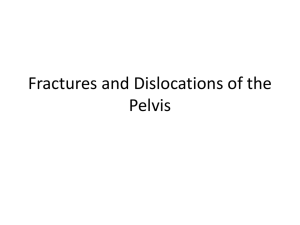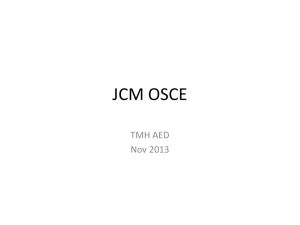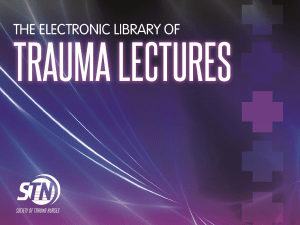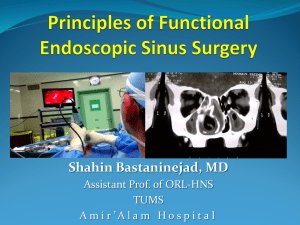Journal Club Slides - JAMA Facial Plastic Surgery
advertisement
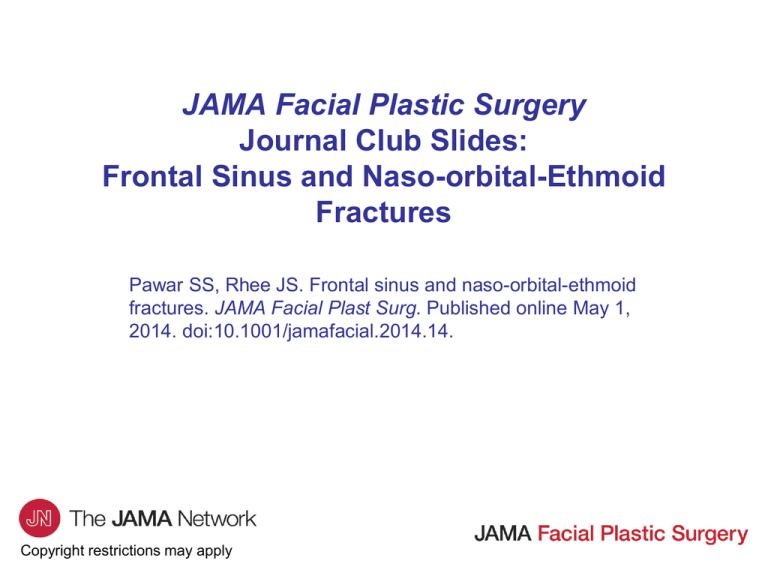
JAMA Facial Plastic Surgery Journal Club Slides: Frontal Sinus and Naso-orbital-Ethmoid Fractures Pawar SS, Rhee JS. Frontal sinus and naso-orbital-ethmoid fractures. JAMA Facial Plast Surg. Published online May 1, 2014. doi:10.1001/jamafacial.2014.14. Copyright restrictions may apply Introduction • Frontal sinus and naso-orbital-ethmoid (NOE) fractures are among the most challenging injuries in the treatment of maxillofacial trauma. • Goals of frontal sinus fracture treatment include minimizing early and late complications, establishing a “safe sinus,” restoring normal frontal sinus function, and restoring frontal contour. • Goals of NOE fracture repair are to restore intercanthal distance, orbital volume, dorsal support, and nasal tip projection and length. • The primary concerns of frontal sinus and NOE fracture treatment in the pediatric population relate to the associated intracranial injuries and implications for growth of the facial skeleton. Copyright restrictions may apply Purpose • To summarize the current knowledge regarding frontal sinus and NOE fractures and to present some of the recent, evidence-based literature to support current treatment recommendations. Copyright restrictions may apply Relevance to Clinical Practice • Frontal sinus fractures account for 5% to 15% of all facial fractures and typically result from motor vehicle crashes, assaults, and sporting injuries; 75% of patients will have serious concomitant injuries owing to the highenergy mechanisms. • Most common complications of frontal sinus fractures include mucocele, sinusitis, meningitis, osteomyelitis, wound infection, encephalocele, cerebrospinal fluid (CSF) leak, chronic pain, cosmetic deformity, and death. • Approximately 65% of patients with NOE fractures have other concomitant facial fractures, most commonly LeFort or frontal sinus fractures. Copyright restrictions may apply Description of Evidence • A PubMed search of articles from 1990 through 2013 was performed. Search terms included frontal sinus fracture, NOE fracture, naso-orbitoethmoid fracture, naso-ethmoid-orbital fracture, and nasoethmoid fracture. Copyright restrictions may apply Description of Evidence Treatment Algorithm for Frontal Sinus Fractures Copyright restrictions may apply Description of Evidence Classification of NOE Fractures12 Copyright restrictions may apply Controversies and Consensus • Goals of frontal sinus fracture treatment include minimizing early and late complications, establishing a “safe sinus,” restoring normal frontal sinus function, and restoring frontal contour. • Conservative treatment is warranted in minimally displaced or comminuted anterior table fractures. – Although open reduction and internal fixation (ORIF) is an option in the acute setting, many patients go on to recover with minimal visible deformity or concerns. – A delayed secondary endoscopic approach can be used to camouflage a contour defect. Copyright restrictions may apply Controversies and Consensus • Much of the controversy in treatment has to do with the posterior table and frontal sinus outflow tract (FSOT). – Traditional approaches have advocated for frontal sinus obliteration or canalization for fractures of the posterior table. – A “sinus preservation” approach should be considered for: • Nondisplaced or minimally displaced fractures of the anterior wall. • Nondisplaced or minimally displaced posterior wall fractures without clinically significant intracranial injury or persistent CSF leak (traditionally cranialized). • Displaced anterior wall fractures with suspected FSOT involvement (traditionally obliterated). • Displaced anterior and minimally displaced posterior wall fractures without significant intracranial injury or persistent CSF leak (traditionally obliterated or cranialized). Copyright restrictions may apply Controversies and Consensus • Surgical treatment of NOE fractures is guided by the pattern of injury and classification. – Type I fractures: Stable fractures often do not require surgical intervention and patients can be followed clinically. However, displaced and/or unstable fractures will require ORIF. – Type II or III fractures: Both patterns typically require a coronal approach to adequately expose the NOE region. Additionally, transnasal wiring or another canthopexy method is required to restore intercanthal distance and position of the medial canthus. Copyright restrictions may apply Comment • There is increasing evidence supporting sinus preservation approaches in the treatment of selected frontal sinus fractures. – Advantages include shorter operative time with anterior table reduction, less risk of bone fragment devitalization and resorption after the wide exposure needed for sinus obliteration, and avoidance of removing all sinus mucosa in extensively pneumatized frontal sinuses in the acute setting. – Also allows for improved surveillance on computed tomographic imaging and endoscopic examination in the clinic. Copyright restrictions may apply Conclusions • Frontal sinus and NOE fractures present some of the most challenging constellation of injuries within craniomaxillofacial trauma. • Advances in imaging and minimally invasive surgical techniques are introducing more conservative options that may provide better patient outcomes while minimizing the risks and morbidity associated with more traditional treatment approaches. Copyright restrictions may apply Contact Information • If you have questions, please contact the corresponding author: – Sachin S. Pawar, MD, Division of Facial Plastic and Reconstructive Surgery, Department of Otolaryngology and Communication Sciences, Medical College of Wisconsin, 9200 W Wisconsin Ave, Milwaukee, WI 53226 (spawar@mcw.edu). Conflict of Interest Disclosures • None reported. Copyright restrictions may apply
